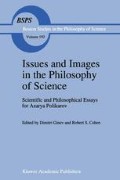Abstract
Symmetries play an important role in the history of science and art.3 In the development of modern physics the use of symmetry arguments changed radically in the beginning of the 20th century. To a considerable extent the new rise of symmetry in theoretical physics is due to A. Einstein, H. Weyl, and E. Wigner.4
I had the privilege to discuss these topics with Professor Azaria Polikarov, who stayed at the University of Heidelberg as a visiting professor when I worked there on my “Habilitationsschrift” (Stoeckler 1987). In many tea hours he provided cake, valuable hints and encouraging criticisms. It is my pleasure to dedicate this paper to the 75th anniversary of my fatherly friend.
See Weyl (1952).
Cf. Radicati (1979), p. 524.
Access this chapter
Tax calculation will be finalised at checkout
Purchases are for personal use only
Preview
Unable to display preview. Download preview PDF.
References
Aitchison, I. (1982), An Informal Introduction to Gauge Field Theories (Cambridge).
Dodd, J. E. (1984), The Ideas of Particle Physics (Cambridge).
Falkenburg, B. (1988), ‘The Unifying Role of Symmetry Principles in Particle Physics’, Ratio (New Series) 1(2), pp. 113–134.
Feynman, R. P. (1967), The Character of Physical Law (Cambridge, Mass.)
Friedman, M. (1974), ‘Explanation and Scientific Understanding’, Journal of Philosophy 71, pp. 5–19.
Heisenberg, W. (1985), Heisenberg, Collected Works, Series C, Volume III, Munich 1985 (In the quotation from this Volume, I omit all information about title and original place of publication).
Heisenberg, W. (1971), Physics and Beyond (New York).
— (1976a), ‘The Nature of Elementary Particles’, Physics Today 29(3), pp. 32–39.
— (1976b), ‘Cosmic Radiation and Fundamental Problems in Physics’, Die Naturwis senschaften 63, pp. 63–67.
Liesenfeld, C. (1992), Philosophische Weltbilder des 20. Jahrhunderts (Würzburg)
Pickering, A. (1984), Constructing Quarks. A Sociological History of Particle Physics (Edinburgh).
Polikarov, A. (1983), Methodological Problems of Science (Sofia).
Radicati di Brozolo, L. (1979), ‘Einstein and the Role of Symmetry in Modern Physics’, in Relativity, Quanta and Cosmology, F. de Finis (ed.) (New York), pp. 523–535.
Redhead, M. (1975), ‘Symmetry in Intertheory Relations’, Synthese 32, pp. 77–112.
— (1988), ‘A Philosopher Looks at Quantum Field Theory’, in Philosophical Foundations of Quantum Field Theory, H. R. Brown and R. Harré (eds.) (Oxford), pp. 9–23
Stoeckler, M. (1987), ‘Philosophische Probleme der Elementarteilchenphysik’, Habilitationsschrift, Gießen 1987 (unpublished).
— (1993), ‘Hat sich Werner Heisenberg zu Recht auf Platon berufen?’ in Werner Heisenberg-Physiker und Philosoph, B. Geyer et al. (eds.) (Berlin), pp. 335–343.
van Fraassen, Bas C. (1989), Laws and Symmetry (Oxford).
Weinberg, S. (1980), ‘Conceptual Foundations of the Unified Theory of Weak and Electromagnetic Interactions’, Reviews of Modern Physics 52, pp. 515–523.
Weyl, H. (1952), Symmetry (Princeton).
Author information
Authors and Affiliations
Editor information
Editors and Affiliations
Rights and permissions
Copyright information
© 1997 Springer Science+Business Media Dordrecht
About this chapter
Cite this chapter
Stoeckler, M. (1997). Symmetries and Explanations: The Lessons of Elementary Particle Physics. In: Ginev, D., Cohen, R.S. (eds) Issues and Images in the Philosophy of Science. Boston Studies in the Philosophy of Science, vol 192. Springer, Dordrecht. https://doi.org/10.1007/978-94-011-5788-9_20
Download citation
DOI: https://doi.org/10.1007/978-94-011-5788-9_20
Publisher Name: Springer, Dordrecht
Print ISBN: 978-94-010-6443-9
Online ISBN: 978-94-011-5788-9
eBook Packages: Springer Book Archive

